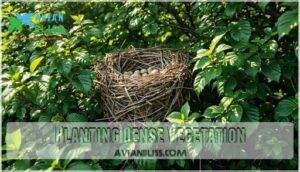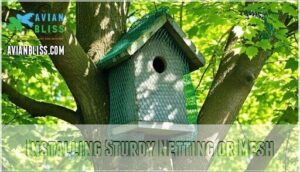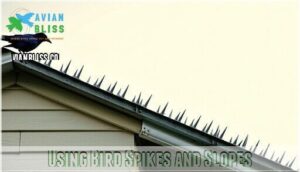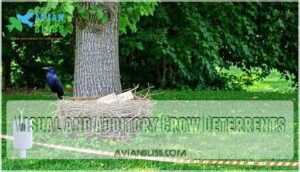This site is supported by our readers. We may earn a commission, at no cost to you, if you purchase through links.
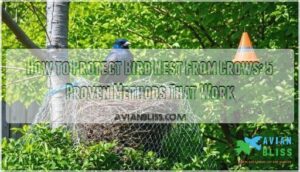
Install physical barriers like sturdy netting or mesh around vulnerable areas, and add tree baffles to prevent climbing access. Visual deterrents work well too – hang reflective tape or use decoy owls to discourage crow visits.
Remove food attractants like spilled birdseed from your yard, since crows remember reliable food sources. Keep cats indoors during nesting season for extra protection. The secret lies in layering multiple strategies together for maximum effectiveness.
Table Of Contents
- Key Takeaways
- Why Do Crows Attack Bird Nests?
- How to Make Nests Less Visible to Crows
- Effective Physical Barriers for Nest Protection
- Visual and Auditory Crow Deterrents
- Maintenance and Environmental Strategies
- Frequently Asked Questions (FAQs)
- What attracts crows to bird nests in the first place?
- How do I know if crows are targeting my nest?
- Will crows attack nests with eggs or chicks inside?
- Can I relocate a nest to avoid crow attacks?
- What time of year do crows attack nests most?
- Can crows remember and return to nest locations?
- How far should deterrents be placed from nests?
- Are there natural predators that control crow populations?
- Conclusion
Key Takeaways
- Layer multiple defense strategies together – You’ll get the best results by combining dense vegetation cover, physical barriers like netting, and visual deterrents rather than relying on just one method.
- Position nests in thick vegetation away from open areas – Crows rely heavily on visual scanning to find nests, so you’ll dramatically reduce detection rates by choosing concealed locations with dense foliage coverage.
- Install sturdy physical barriers around vulnerable nests – You can use wire mesh with 1.5-2 inch openings, tree baffles positioned 4-6 feet high, or bird spikes on nearby perching surfaces to block crow access routes.
- Remove food attractants from your yard consistently – You’ll prevent crows from establishing your property as a reliable food source by securing trash bins, cleaning up birdseed spillage, and eliminating scraps from outdoor eating areas.
Why Do Crows Attack Bird Nests?
You’ll find that crows attack bird nests primarily because they’re opportunistic feeders searching for easy protein sources like eggs and helpless chicks.
These intelligent corvids are responsible for up to 96% of nest predation in some studies, particularly targeting exposed nests where they can quickly grab a meal.
These intelligent predators cause up to 96% of nest failures in some areas
Crow Behavior and Nest Predation
Most crows are smart predators that actively hunt eggs and baby birds. Understanding their predation patterns helps you protect vulnerable nests from these persistent corvids.
Here’s how crow intelligence affects nesting habits:
- Crows use visual cues to locate nests by watching parent birds
- Urban crows have adapted to exploit fragmented habitats effectively
- They develop "search images" to systematically find multiple nests
- Corvid impact increases dramatically with local population density
- Preventing predators requires understanding their trap-lining behavior patterns
Notably, some corvids have been observed using anti-bird spikes in nests.
Common Vulnerabilities in Bird Nests
Certain nest locations put your feathered friends at serious risk from crow predation. Exposed nests in open areas lack natural cover, making them easy targets. Young nests with fresh materials often attract attention through scent trails. Poor nest materials and accessible positioning create vulnerability windows that crows exploit effectively. Birds like swallows use mud and clay to build nests, but these can still be vulnerable if not well-placed.
| Vulnerability Factor | Risk Level |
|---|---|
| Exposed Nests in Open Areas | High |
| Fresh Nest Materials/Scent | Medium-High |
| Low Branch Placement | High |
| Minimal Vegetation Cover | High |
| Recently Disturbed Sites | Medium |
Impact of Crow Abundance on Nest Safety
Higher crow population density directly increases predation rate correlation with nest failures. Urban sprawl effects create more crow nesting opportunities, making bird species vulnerability worse in developed areas.
When crow populations grow dense, protecting nests becomes harder. Studies show corvids cause 83-96% of nest predation in some areas.
Your property protection efforts must account for local crow abundance to succeed.
How to Make Nests Less Visible to Crows
Dense vegetation and concealed locations substantially reduce crow nest detection rates, as research shows these intelligent birds rely heavily on visual scanning to locate prey.
You can strategically plant thick bushes around nesting areas and choose spots with natural cover to create effective camouflage barriers.
Choosing Concealed Nest Locations
When protecting nests from crow attacks, habitat selection matters most. Choose nest locations with dense foliage coverage that naturally blocks visibility from above. Natural cavities in thick branches provide excellent camouflage integration.
Position nests at moderate nest height within dense shrubs rather than exposed areas. Crows struggle to spot well-concealed nests among heavy vegetation, making property protection more effective.
Planting Dense Vegetation
Strategic placement of native plantings creates natural crow exclusion zones around nesting areas. Dense thorny bushes like hawthorn or blackberry provide excellent deterrent strategies while supporting habitat diversity.
You’ll want to plant these barriers within ten feet of active nest sites. The thick foliage blocks crow sightlines and makes access difficult. A key element is providing safe havens for the birds you’re trying to protect.
This natural approach works better than artificial crow deterrents for long-term nesting protection.
Using Camouflage Materials
Natural materials work better than artificial ones for camouflage effectiveness. Wrap nest boxes with twigs, bark strips, or dried leaves matching surrounding vegetation. This pattern disruption breaks up recognizable shapes that crows spot easily.
Seasonal camouflage adjustments help too—use brown materials in fall, green in spring. These deterrent strategies make nesting sites blend seamlessly into their environment, reducing crow detection substantially.
Effective Physical Barriers for Nest Protection
You’ll need physical barriers to create real obstacles that stop crows from reaching vulnerable nests directly.
Research shows that sturdy netting, bird spikes, and tree baffles work by blocking access routes that crows usually use to attack nests.
Installing Sturdy Netting or Mesh
Wire mesh offers the highest quality for nest box protection during nesting season. You’ll want polyethylene or nylon netting material types with 1.5-2 inch openings. Proper installation requires tight fitting around nesting areas to stop climbing predators. For ideal defense, consider how mesh size affects protection.
- Mesh size matters – smaller openings block more threats
- Professional-grade netting lasts 15+ years outdoors
- Installation works best with two people for safety
- Regular maintenance prevents gaps that compromise protection
These physical deterrents create an impenetrable barrier when installed correctly.
Using Bird Spikes and Slopes
Bird spikes create unstable perching surfaces that discourage crows from landing near nests. Install spikes on ledges, windowsills, and flat surfaces where crows usually perch. Choose plastic or stainless steel spikes for spike material safety. Position slopes at 45-degree angles for ideal slope angle effectiveness. Follow installation best practices by securing spikes firmly to prevent gaps.
Regular maintenance requirements include cleaning debris monthly. Consider aesthetic considerations by selecting neutral-colored bird repellents that blend with surroundings while protecting nesting areas.
To further protect nests, consider installing stovepipe and conical baffles.
Adding Tree Baffles to Prevent Climbing
Tree baffles stop climbing predators from reaching your nest or birdhouse. These protective measures work against raccoons, squirrels, and snakes.
Consider these factors for effective baffle placement:
- Baffle Material: Choose smooth metal or plastic that predator species can’t grip
- Tree Health: Make sure branches won’t support predator weight above the baffle
- Baffle Placement: Install 4-6 feet high on trunk below nest location
- Baffle Maintenance: Check regularly for damage or gaps that allow access
Visual and Auditory Crow Deterrents
You can exploit crow psychology by using visual and sound distractions that trigger their natural caution responses. Reflective tape, decoy predators, and motion-activated devices create sensory disruptions that make crows think twice before approaching nest areas.
Hanging Reflective Tape or Shiny Objects
Reflective tape and shiny objects create visual discomfort that reaches crows’ deterrent habituation risk threshold. Position reflective devices 3-5 feet from nests to enhance crow discomfort threshold effectiveness. These bird repellents work by disrupting corvid visual processing, making crow nesting areas less appealing. Crows, contrary to popular belief, exhibit avoidance of reflective objects.
| Reflective Device Type | Placement Distance |
|---|---|
| Holographic tape | 3-4 feet from nest |
| CD/DVD discs | 4-5 feet overhead |
| Mylar strips | 2-3 feet perimeter |
Alternative visual deterrents include aluminum pie plates and mirror fragments secured nearby.
Using Decoys and Scare Devices
Fake owls and hawk decoys can deter crows through predator mimicry, but scarecrow placement matters for decoy effectiveness. Position these bird repellent devices near the nest with clear sight lines.
Move decoys regularly to prevent habituation prevention, as crows quickly learn fake threats. Consider purchasing an owl decoy for maximum crow deterrence.
Combine with other physical deterrents and reflective devices for better results against persistent corvids.
Employing Motion-Activated Noise Makers
Motion-activated noise makers work like silent sentinels around the nest. These bird repellents trigger high-frequency sounds when crows approach.
Proper noise maker placement near vulnerable areas maximizes effectiveness. Adjust trigger sensitivity to avoid false alarms from wind.
Consider crow habituation concerns – rotate sound frequency selection weekly. Solar power source options work best outdoors to deter crows consistently.
Maintenance and Environmental Strategies
You’ll protect nests most effectively when you remove attractants like pet food and bird seed that draw crows to your yard.
Keeping cats indoors during nesting season and checking nest areas weekly helps you spot problems before crows discover vulnerable young birds.
Removing Food Attractants Nearby
Your yard’s leftovers become crow magnets, drawing these clever predators closer to vulnerable nests. Eliminate scraps from picnic areas and secure trash bins with tight lids to reduce crow visits.
Limit birdseed spillage under feeders since excess seeds attract crows and other nest predators.
Clean BBQ areas thoroughly after use, removing grease and food remnants that signal easy meals to opportunistic crows.
Keeping Pets Indoors During Nesting Season
Your cat’s hunting instincts pose serious Pet Predation Risks during nesting season. Keep pets indoors when birds are actively nesting to protect vulnerable nests from predators.
- Provide Indoor Enrichment Needs through puzzle toys and climbing structures
- Schedule brief Supervised Outdoor Time on leashes or in enclosed runs
- Remember that Breed Predatory Instincts vary, with some cats showing stronger hunting behaviors
Limiting Roaming Range reduces nest disturbance substantially.
Regularly Monitoring and Cleaning Nest Sites
Beyond keeping pets inside, you’ll need regular nest monitoring to spot crow threats early. Early intervention benefits include preventing crow attraction to weak nests. Monitor nesting sites from a distance using binoculars.
Check nests twice weekly for parasite infestation and debris removal needs. Safe cleaning practices involve removing old materials after birds fledge.
Bird repellents work better when monitoring frequency importance guides your application timing.
Frequently Asked Questions (FAQs)
What attracts crows to bird nests in the first place?
Crows target bird nests because they’re opportunistic omnivores seeking easy protein sources. You’ll find they’re drawn to eggs and helpless nestlings, which provide essential nutrients during their own breeding season.
How do I know if crows are targeting my nest?
Sarah noticed feathers scattered beneath her robin’s nest daily.
You’ll spot targeting signs: increased crow activity near nesting areas, loud cawing sessions, and direct approaches toward specific trees or shrubs containing nests.
Will crows attack nests with eggs or chicks inside?
Yes, crows actively hunt for both eggs and chicks. They’re opportunistic predators that’ll raid nests whenever they find them.
Eggs and young birds make easy, protein-rich meals that crows can’t resist taking.
Can I relocate a nest to avoid crow attacks?
One robin family lost three broods after repeatedly moving their nest closer to a busy walkway. Don’t relocate active nests—it’s illegal and stresses birds.
Instead, you’ll protect existing nests better by creating barriers around them.
What time of year do crows attack nests most?
Spring breeding season brings peak crow predation. You’ll see most attacks from April through July when parent birds are nesting. Crows target eggs and helpless chicks during this vulnerable window.
Can crows remember and return to nest locations?
Crows have memories like elephants – they never forget your face. These exceptional birds possess excellent spatial memory, remembering nesting sites and food locations year after year, often returning to reuse their nests.
How far should deterrents be placed from nests?
Place deterrents 10-15 feet from nests for maximum effectiveness. This distance prevents crows from easily bypassing barriers while avoiding direct disturbance to parent birds during feeding visits.
Are there natural predators that control crow populations?
Like nature’s own bouncers, hawks, owls, and eagles do prey on crows, though they can’t really control their numbers. Owls, hawks, and falcons are natural predators, but crows fight back.
Conclusion
Ready to transform your yard into a crow-proof sanctuary? Successfully learning how to protect bird nests from crows requires combining multiple defense strategies. Dense vegetation, physical barriers, and visual deterrents work best when used together.
Remove food sources that attract crows, and monitor your protective measures regularly. Crows are intelligent and adaptable, so rotating your deterrent methods keeps them guessing.
With consistent application of these proven techniques, you’ll substantially reduce nest predation rates and give nesting birds the safe haven they deserve.


